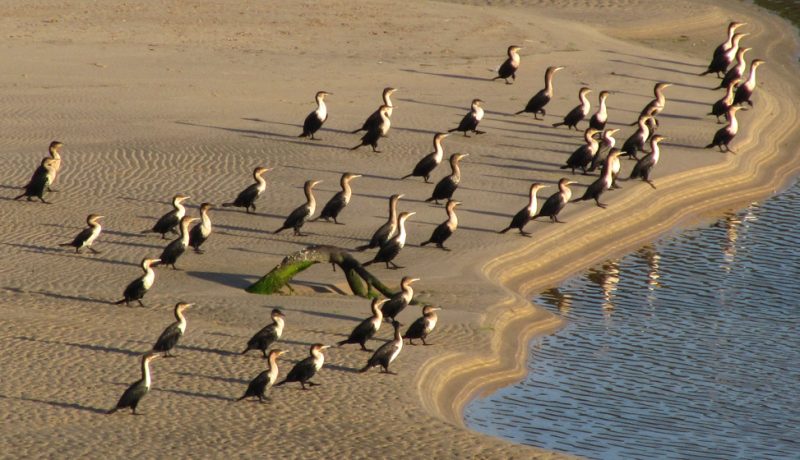Identification
In theory, the White-breasted Cormorant is an easy species to identify (but there are imposters, see later). In adults the top half of the front is white, in immatures the front is entirely white (see the two images below). In adults, the amount of white is variable, and so is the detail of the yellow/orange markings on the head. This also varies with stage of breeding; the colours are more intense while breeding than outside the breeding season. Males and females have the same plumage, with males averaging larger than females.
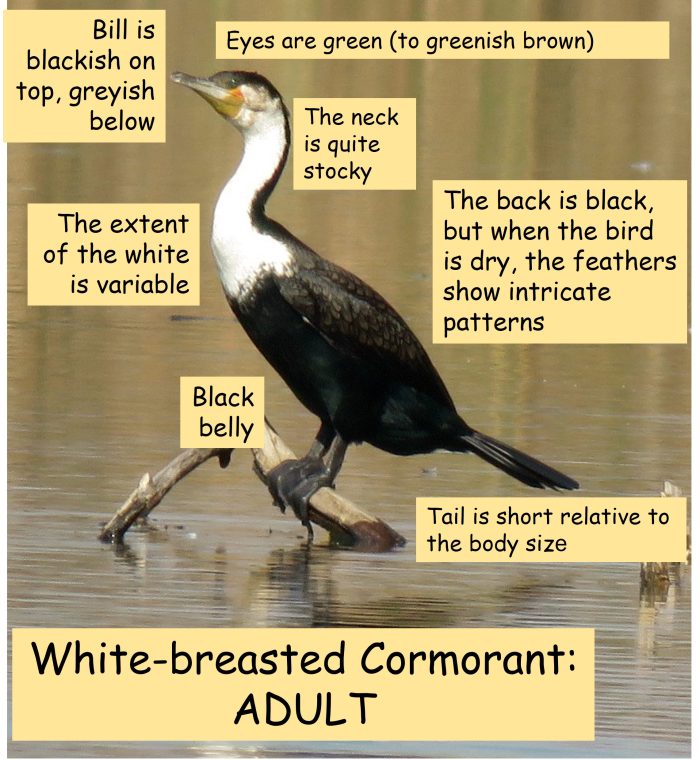
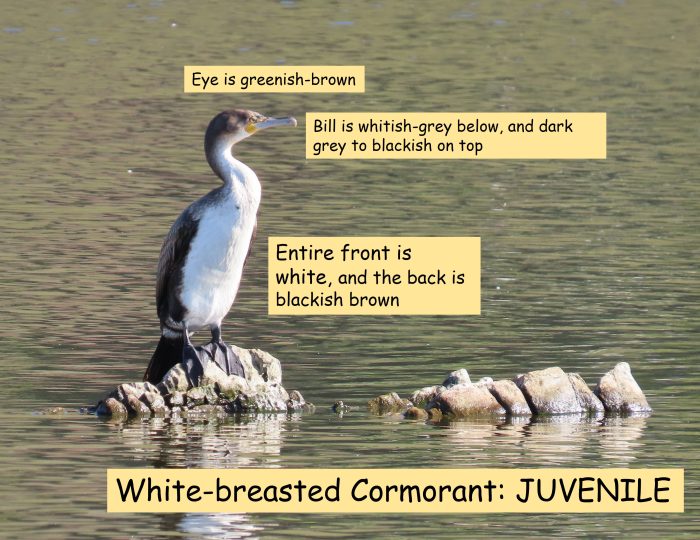
This head and shoulders photo shows the detail of the structure of the face and neck. This particular bird could be called the white-necked cormorant; the white “breast” does not extend to the breast. This photo also illustrates the green sheen of the apparently black body feathers, something seldom seen.
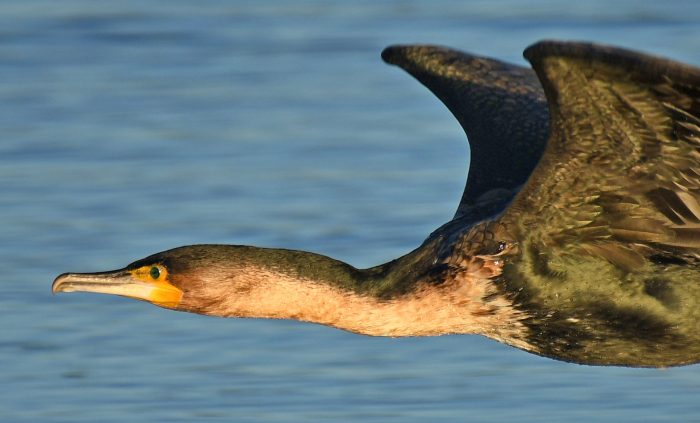
Derek Oosthuizen. BirdPix 123538
The fieldguides tend to illustrate White-breasted Cormorants with their white thigh patches on display, as in the photo below. In reality these are seldom visible; out of more than one thousand photographic records in the Virtual Museum, there were only a handful in which the white thigh patches could be seen.
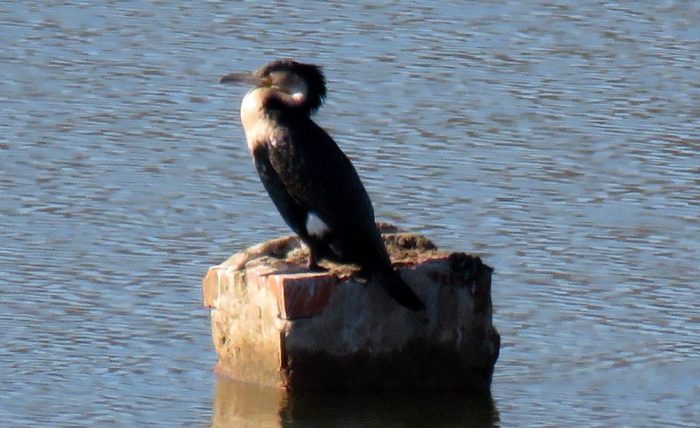
Les Underhill BirdPix 56881
Confusing species
The African Darter Anhinga rufa and two of southern Africa’s other four cormorant species are sometimes sufficiently “white-breasted” that they can be identified as White-breasted Cormorants by the unwary birder! The two confusable cormorants are Reed Cormorant Microcarbo africanus and Crowned Cormorant M. coronatus. Juvenile Cape Cormorant Phalacrocorax capensis are sometimes a pale brown in front, and Bank Cormorants P. neglectus are never white in front.
We look at the African Darter first:
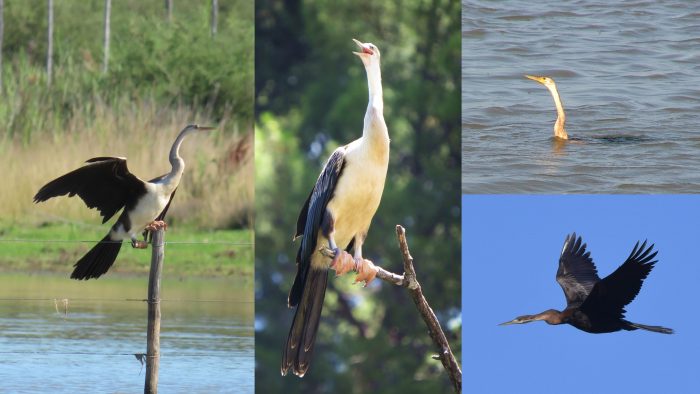
Left: New Holme Dam, Northern Cape, Jon Blanco, BirdPix 214771; centre: Grootfontein, Eastern Cape, Tino Hershelman, BirdPix 48320; top right: David Kennedy, Berg River estuary BirdPix 7446;
bottom right: Vanschoorsdrift, Western Cape, Gerald Wingate, BirdPix 192923
The three photos of African Darters with white fronts are juveniles. Not all juveniles are as white as these, but the front is always a pale shade of brown. The key distinction is the neck. The darter has a long thin neck; the neck of the White-breasted Cormorant is, by comparison, short and stocky. This difference between the species is conspicuous in flight too; the African Darter is a walking stick with wings attached.
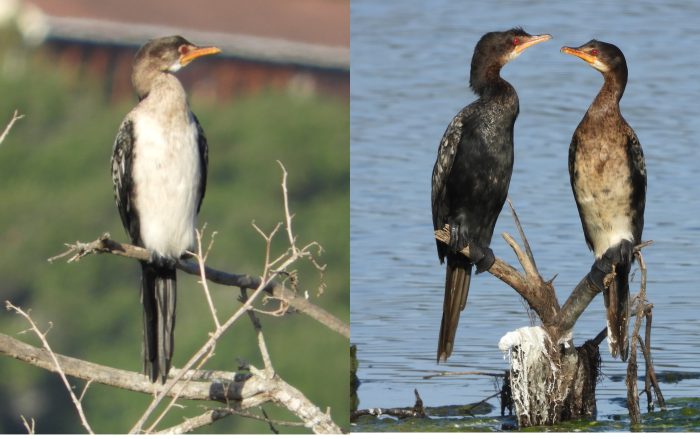
Young Reed Cormorants also sometimes have completely white breasts, but this is variable. They are substantially smaller than White-breasted Cormorants, but at a distance it is non-trivial to gauge relative sizes. The tail of the Reed Cormorant is relatively much longer than that of White-breasted. If you are close enough and the light is good, then look at the eyes! Reed Cormorants have reddish eyes, brownish in juveniles, and White-breasted Cormorants have blue eyes in the breeding season, and green eyes out of it, but the juveniles also have brownish eyes. These eye colour are surprisingly conspicuous, even at quite long distances. Another useful diagnostic feature is the bill, somewhere between yellowish and yellow in Reed Cormorants, and somewhere between along the continuum whitish via blueish to blackish in the White-breasted Cormorant!

Left: Yzerfontein, Western Cape, Fanie Rautenbach, BirdPix 3667; right: Blaauberg, WC, Les Underhill, BirdPix 183328
Along the coastline, the only potential confusion is with young Crowned Cormorants. But these have brownish fronts, and are never really white. Crowned Cormorants have relatively longer tails than White-breasted Cormorants. The eyes are shades between red and brown.
Habitat
If a place has enough water for it to swim and dive in, then White-breasted Cormorant is a possibility. It is equally at home in seawater as in freshwater, the only cormorant in southern Africa to have both coastal and freshwater populations.
In the interior it occurs at dams of all sizes, from farm dam to large reservoirs, at sewage works and along rivers and streams. On the coast, in occurs on both sandy and rocky shorelines, but seldom far from land.
Distribution
The primary message from this distribution map from the bird atlas is that White-breasted Cormorants occur both on the coastline and in the interior. Of the five cormorant species in South Africa, this is the only one to be equally at home in seawater and freshwater.
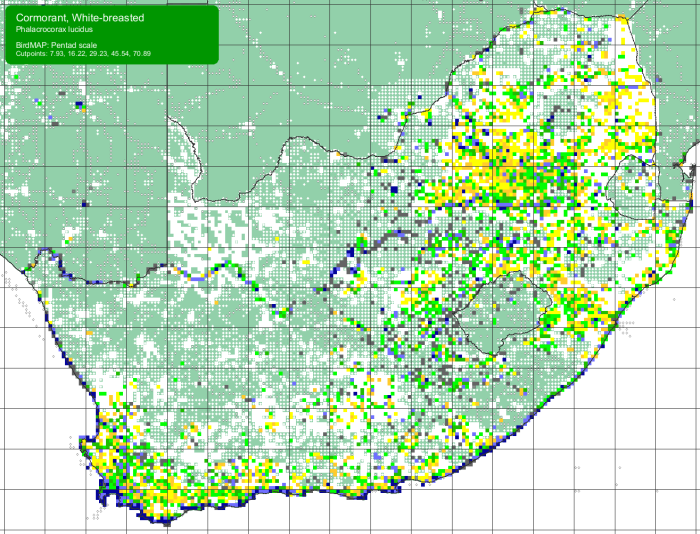
For the interior of South Africa, this distribution map from the bird atlas is effectively a map of the distribution of wetlands. The single most striking thing about this map is how it traces out the route of the Orange River through the otherwise arid Northern Cape. The Vaal River is also clearly defined. The rest of the distribution across the interior defines the regions where wetlands, either natural (such as pans) or artificial (such as farm dams, reservoirs, sewage works) occur. Likewise, it demonstrates where wetlands are rare: the Karoo, Kalahari, and parts of the Eastern Cape and KwaZulu-Natal, etc).
The distribution map shows that the entire coastline of South Africa is occupied by White-breasted Cormorants. The coastal distribution continues northwards in Africa to about Angola in the west coast and Tanzania on the east coast.
Behaviour
Most seabirds have water-repellent feathers, so that when they dive their plumage traps air, which becomes a layer of insulation between the warm-blooded bird and the cold water. Cormorants, including White-breasted, get wet in water. On the one hand this means that, compared to other seabirds, they are less buoyant, they can dive deeper and they can swim faster. This gives them an edge in catching their prey, mostly fish. On the other hand, their plumage gets waterlogged and they get cold. So the most characteristic behaviour of cormorants is to stand, preferably in the sun, with wings outstretched, to get dry and warm.
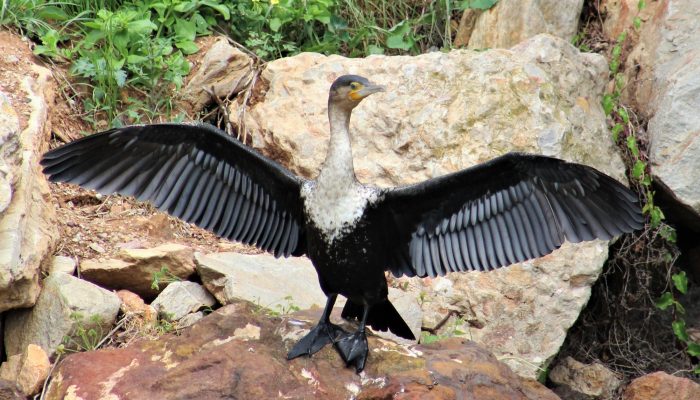
This White-breasted Cormorant is holding out its wings to get dry and warm. This activity is called wing-spreading, and it is done after every bout of feeding. Most birds have a total of 19 wing feathers; cormorants are exceptional and have more than 30!
Breeding
Nest sites have one thing in common. They aim to find places where there is safety from predation. White-breasted Cormorants usually breed in colonies, often with other species of waterbirds. On the coastline it breeds on ledges on cliffs, on offshore rock stacks, on islands and wrecks. Inland breeding sites are usually trees, and often dead tree skeletons left standing in dams long after the dam has filled with water. They breed on platforms, custom-built for the purpose. A selection of breeding sites is illustrated below.
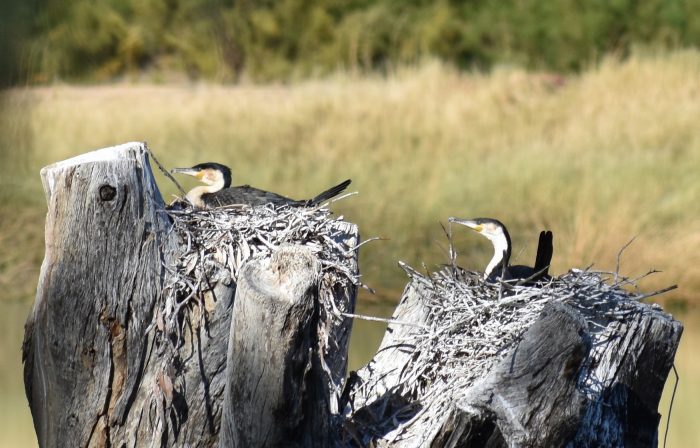

Dieter Oschadleus, BirdPix 35785
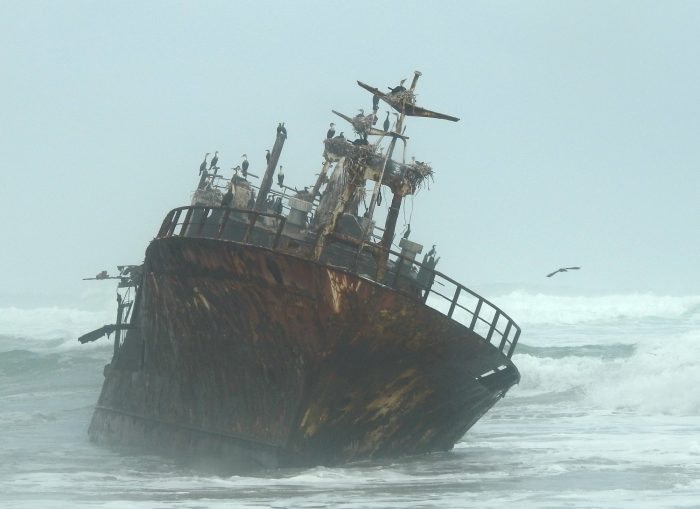
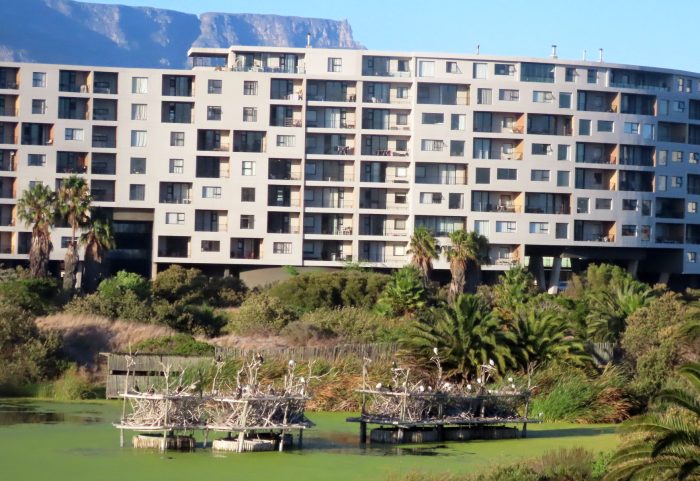
Les Underhill, BirdPix 254631
Predator free breeding sites are in short supply, so suitable places are quickly adopted: some are created by accident, such as shipwrecks, and some are created by design, such as breeding platforms.
Further resources: A selection of papers
- Species text in the first bird atlas (1997) White-breasted Cormorant Phalacrocorax carbo
- Daniel K, Quintana I, Underhill LG (2020) Sleeping on a tightrope: White-breasted Cormorants Phalacrocorax lucidus and African Darters Anhinga rufa roosting on transmission lines. Biodiversity Observations 11.5: 1-7.
More common names: Witborsduiker (Afrikaans), Cormoran à poitrine blanche (French), Weißbrustkormoran (German), Corvo-marinho-de-faces-brancas (Portuguese), Cormorán grande (Spanish), Afrikaanse Aalscholver (Dutch).
Photographic acknowledgements: The photographs in this identification guide are from the BDI Virtual Museum. The photographers continue to own the copyright on these images.
Recommended citation format: Underhill LG 2023. White-breasted Cormorant Phalacrocorax lucidus. Biodiversity and Development Institute. Available online at http://thebdi.org/2023/06/18/white-breasted-cormorant-phalocrocorax-lucidus/

